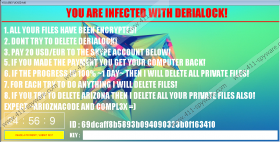DeriaLock Ransomware Removal Guide
DeriaLock Ransomware is not a duplicate of another infamous ransomware infection, which is quite rare, considering that most threats of this kind are almost identical. Although this particular infection works just like any other malicious file encryptor, it involves Skype, which is a completely new feature. According to our research team, it is most likely that this infection is still being developed, as it does not seem to function properly at this moment. Unfortunately, a new version of this ransomware could be released, and this seemingly dysfunctional version could be upgraded. Though it does not look like you can pay the ransom right now, we have a warning for you in case this becomes possible: Cyber criminals are not trustworthy! Who can guarantee that you will get the decryption key after you communicate with cyber crooks and transfer them your money? No one can guarantee that, which is why we suggest looking at other options and, most importantly, deleting DeriaLock Ransomware as soon as possible.
Have you realized that the malicious DeriaLock Ransomware has corrupted your operating system soon after you opened a suspicious file sent to you via spam email? Our malware analysts warn that this devious ransomware spreads via spam emails, and so you have to be cautious about the emails you open, trust, and interact with. Once the infection is executed, a copy of the malicious .exe file is copied to %APPDATA%\Microsoft\Windows\Start Menu\Programs\Startup. In our case, the name of the copy was “LOGON.exe” but keep in mind that this name could be different for you. The infection is copied so that it would be harder for you to eliminate it, and this is the reason why DeriaLock Ransomware also locks your screen. Upon execution, this infection closes all active apps and displays a window with the ransom note that you simply cannot disable. Notably, the ransomware blocks Task Manager, and so you are stopped from disabling the lockdown. Because you are denied access to your PC, you might be unsure if your files were encrypted. Unfortunately, we have to disappoint you by saying that they were.
When DeriaLock Ransomware encrypts your files, it attaches the “.daria” extension to them. The current version of this dangerous threat encrypts the files under %USERPROFILE% (including subfolders), and it is also capable of corrupting .exe files. The ransom note reassures you that your files were actually encrypted and then it pushes you to make a ransom payment. The fee that you are expected to pay is 20 USD or 20 EUR, and you are expected to pay it within 1 day. This is where things get confusing: It is unclear how you are supposed to pay this money. Our guess is that cyber criminals will provide you with a link routing to a payment page and then, after the money is transferred, you should get a key that has to be entered into the box attached to the ransom note. But the Skype name representing cyber crooks is unknown, which makes communication with them impossible. Unfortunately, at the time of research, there was no other way to get the decryption key, which is why we hope that your files are backed up.
The malicious DeriaLock Ransomware locks your screen, and that creates problems when operating your Windows system or deleting the infection. Luckily, there is a way you can reboot your PC in Safe Mode and eliminate the malicious elements with ease. The instructions below explain how to access Safe Mode and remove DeriaLock Ransomware. If you are having any issues with the process, please start a conversation in the comments section below without any hesitation. Note that you can also choose to employ automated malware detection and removal software for the elimination of malware. If this is your choice, you have to access Safe Mode with Networking to gain access to the web. Follow the same guide, but choose Safe Mode with Networking instead of Safe Mode. If you follow the manual removal option, do not forget to take care of Windows protection because malware could slither in before you know it.
How to delete DeriaLock Ransomware
Windows 10:
- Navigate to the Taskbar and click the Windows button.
- Click Power and then select Restart while holding down the Shift key.
- Open the Troubleshooting menu and then move to Advanced options.
- Navigate to the Startup Settings menu and then click Restart.
- In the new menu that appears, choose the F4 option for Safe Mode.
Windows 8 or Windows 8.1:
- In Metro UI move the cursor to the bottom right corner to access Charm bar.
- Repeat steps 2-5 from the guide created for Windows 10 users.
Windows Vista or Windows 7:
- Restart the PC and wait for the BIOS to load.
- Immediately start tapping the F8 keys to access the boot menu.
- Select Safe Mode using the arrow keys and tap Enter.
Windows XP:
- Repeat steps 1-3 from the guide created for Windows Vista/7 users.
- Click YES when the Windows is running in safe mode alert shows up.
Eliminate malicious files:
- Delete the malicious .exe file (if you downloaded it, you should know its location).
- Launch Windows Explorer by tapping Win+E keys.
- Type %APPDATA%\Microsoft\Windows\Start Menu\Programs\Startup into the bar at the top and tap Enter to access the folder.
- Delete the copy of the .exe file, which might have been renamed to LOGON.exe.
- Reboot your PC in Normal Mode and immediately perform a full system scan.
DeriaLock Ransomware Screenshots:



